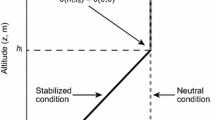Summary
Measurements of222Rn concentrations near the mouth of a mountain canyon show diurnal changes consistent with the accepted model of canyon winds wherein surface air moving downslope at night accumulates radon, resulting in a steady increase in radon concentration and a decrease in air temperature. Maximum levels of approximately 0.5 picocurie/liter can occur. With the onset of up-canyon wind after surface heating in the morning, the radon level near the mouth of the canyon drops rapidly to nearly one tenth of the nocturnal maximum. The steady nighttime buildup can be interrupted by wind patterns that intercept the mountain at levels well below the mountaintop or by turbulent mixing induced by lee waves or other dynamic processes that increase temperature and decrease radon concentrations of the canyon air during the night. Measurements on a vertical section of the canyon near its mouth indicate high concentrations on the canyon floor under conditions of positive temperature lapse. Diurnal concentration patterns of radon at the top of the mountain ridge above the canyon show maxima in late moring and again in the early night hours.
Zusammenfassung
Die222Rn-Konzentration an der Mündung einer Bergschlucht weist tägliche Schwankungen auf, übereinstimmend mit der bekannten Vorstellung vom Talwindsystem. Die während der Nacht abwärts wehende Luftmasse reichert Radon an, und die Lufttemperatur nimmt dabei ab. Maximale Werte von etwa 0.5 pC/l können vorkommen. Beim am Morgen infolge Oberflächenerwärmung einsetzenden Talaufwind sinkt die Radonkonzentration auf etwa ein Zehntel des nächtlichen Maximums. Der stetige Anstieg der Radonkonzentration während der Nacht kann unterbrochen werden durch Windströmungen, die beträchtlich unterhalb der Berggipfel auf das Gebirge auftreffen, durch Wirbelströmung infolge von Leewellen oder durch andere dynamische Prozesse, welche eine nächtliche Temperaturerhöhung und Radonverminderung der Luft in der Schlucht verursachen. Messungen an einem vertikalen Profil der Schlucht nahe ihrer Mündung ergeben eine hohe Radonkonzentration am Boden der Schlucht bei Temperaturinversionen. Auf dem der Schlucht benachbarten Kamm treten Konzentrationsmaxima am späten Morgen und weiderum in den ersten Nachtstunden auf.
Similar content being viewed by others
References
Defant, F.: Local Winds. Compendium of Meteorology, pp. 655–672, American Meteorol. Soc. 1951.
Fleagle, R. G.: A Theory of Air Drainage. J. of Meteor.7, 227–232 (1950).
Israël, H.: Radioactivity of the Atmosphere. Compendium of Meteorology, pp. 155–161, American Meteorol. Soc. 1951.
Kraner, H. W., G. L. Schroeder, and R. D. Evans: Measurements of the Effects of Atmospheric Variables on Radon-222 Flux and Soil-Gas Concentrations. The Natural Radiation Environment, pp. 196–199. Chicago: University of Chicago Press, 1964.
Rust, W. D.: Radon Concentration in a Mountain Canyon Environment. Thesis, pp. 22–31, New Mexico Institute of Mining and Technology, Socorro, N. M., 1969.
Sisigna, T. I.: Radon Emanation from Soils in the European Part of the USSR and Kazakhstan. Radioactive Isotopes in the Atmosphere and Their Use in Meteorology, pp. 29–33 (English Translation 1967), Atomizdat, 1965.
Thompson, A. H.: Surface Temperature Inversions in a Canyon. J. of Appl. Meteor.6, 287–296 (1967).
Tyson, P. D., Velocity Fluctuations in the Mountain Wind. J. of Atmos. Sci.25, 381–394 (1968).
Wilkening, M. H.: Radon-222 Concentrations in the Convective Patterns of a Mountain Environment. J. of Geophys. Res.75, 1733–1740 (1970).
Author information
Authors and Affiliations
Additional information
Dedicated to the memory of Prof. Hans Israël.
With 6 Figures
Rights and permissions
About this article
Cite this article
Wilkening, M.H., Rust, W.D. Radon-222 concentrations in a mountain canyon environment. Arch. Met. Geoph. Biokl. A. 21, 183–194 (1972). https://doi.org/10.1007/BF02247971
Received:
Issue Date:
DOI: https://doi.org/10.1007/BF02247971



